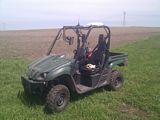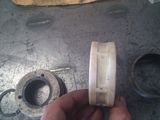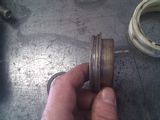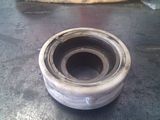2011-4-29
Today was the best day of the week for outdoor work, and it almost got to 70 degrees. I used the warm weather to map some field borders with the Yamaha Rhino. The display is the Insight we use for the planter, a Trimble 262 receiver, and an Intuicom Bridge-M pulling RTK correction data from the IA DOT's RTN via Verizon. What we're doing is mapping out where the waterways are in our fields so that when we plant those fields, the planter will not put seed in the waterway. The seed won't grow there anyway, so we're saving the cost of the seed. Based on the price of seed, and the time it takes to map waterways, I'd estimate this process has a payback of somewhere between $200 to $500 per hour.


2011-4-26
We've seen light rain over the past 24 hours. The high temperature today was in the low 50s, and is forecast to only reach 49 degrees tomorrow. Soil is 100% saturated and tiles are running full. More rain is in the forecast for this weekend.
2011-4-20
The weather is cold and wet. Tonight will be below freezing again, which means the soil temperature isn't anywhere near where it should be for planting corn. The 7 day forecast has a chance of rain on 6 of those days. We probably won't be able to plant any corn this month.
2011-4-16
It was only supposed to get down to 36 degrees last night, but apparently it is colder than that because we have a dusting of snow this morning.

2011-4-15
The wind took down a tree branch, which fell on the windmill tower.

2011-4-14
The wind today was too strong to spray in, so no Treflan. The forecast is for cooler temperatures, meaning the soil temperature isn't going to come up very fast. It could easily be a week before we plant any corn.
2011-4-13
Beautiful day. Some Treflan was sprayed on and incorporated in.
2011-4-11
Our Kinze 3800 has Tru-count pneumatic row clutches on every row, and each year we go through them to clean any dirt out and add a bit of lubrication. We discovered two of them had been assembled with the white ring backwards. These clutches function with such little effort that they still worked.
They can be disassembled and cleaned right on the shaft, but to flip the ring around required removing it from the shaft. The general principle here is that there are two metal halves. One connects to the hex shaft going to all planter row units, the other has a sprocket that runs a chain to the row unit. There is a "slinky" spring connecting them together. Under normal conditions, the drive side tightens the spring which then forces the driven side to turn as well. When you want to turn a row off, air pressure pushes a pin down into the white collar, which holds the spring from turning. As the spring loosens on the drive side, it just slips, and the driven side doesn't turn. When the air pressure goes away and the pin retracts, the spring will self tighten back up on the drive side, and the driven side starts turning again. It is a very clever idea.








2011-4-10

2011-4-9

2011-4-5
Some NH3 is going on, a few people are doing waterway work, but we aren't getting serious about tillage yet.

2011-4-2
Tile season again.





